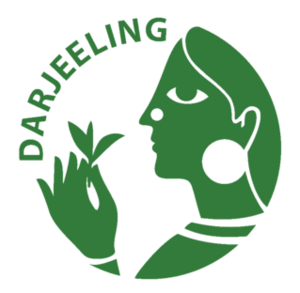Darjeeling tea facts for kids
| Darjeeling, India, Darjeeling tea in variety, Black tea.jpg | |
| Type: | Black (green, white and oolong also produced) |
|
|
|
| Other names: | |
| Origin: | India |
|
|
|
| Quick description: | Floral, fruit aroma, muscatel |
|
|
|
| Temperature: | 90 °C (194 °F) to 95 °C (203 °F) |
| Time: | 3 to 4 minutes |
Darjeeling tea is a special type of tea. It comes from the Camellia sinensis plant. This tea is grown and made in the Darjeeling and Kalimpong Districts. These areas are in West Bengal, India.
Since 2004, the name Darjeeling tea has been officially protected. This means only tea from certain farms in Darjeeling and Kalimpong can use this name. Most Darjeeling tea is black tea. But some farms also make green, white, and oolong teas.
Tea leaves are picked from March to November. This time is split into four main picking seasons, called "flushes."
- The first flush happens in spring. These are the first new leaves after winter. They make a light, flowery tea. It has a slightly sharp taste. This flush can also be used for white tea.
- The second flush is picked in May and June. At this time, tiny insects called leafhoppers and moths attack the plants. This makes the leaves create a special "muscatel" smell and taste. It's like a sweet, grape-like flavor.
- The monsoon flush is during the rainy season. Leaves grow fast but don't taste as strong. This tea is often used for mixing with other teas.
- The autumn flush happens after the rain. This tea is similar to the second flush but milder.
Tea plants were first grown in Darjeeling in the mid-1800s. The British wanted a new source of tea outside of China. They tried growing tea in different parts of India. The Darjeeling area, with its cool winters and cloudy weather, was perfect for the sinensis tea plant. Many tea farms were started. Most workers came from Nepal and Sikkim.
After India became independent, Indian businesses bought the tea farms. The Soviet Union became the main buyer of Darjeeling tea. Over time, Darjeeling tea became famous for its unique taste. It was then sold more to countries in Western Europe. Many farms also started getting special labels. These labels showed they were organic, biodynamic, or Fairtrade. The Tea Board of India works hard to protect and promote Darjeeling teas around the world.
Contents
The Story of Darjeeling Tea
Tea plants were first grown in Darjeeling in 1841. A doctor named Archibald Campbell planted them. He worked for the East India Company. The British wanted to find tea outside of China. They had found a new type of tea plant in Assam. They also brought tea seeds from China.
The Chinese tea plant variety (sinensis) grew well in Darjeeling. It liked the higher, cooler places. The first tea farms for business started in 1856. By 1866, there were 39 tea farms in Darjeeling. One farm, Makaibari Tea Estate, built the first factory. This factory helped prepare the tea so it could travel for months to Britain.
Darjeeling grew quickly. Its population went from less than 100 people to 95,000 by 1885. Most new people were workers from Nepal and Sikkim. New ways of transport, like the Darjeeling Himalayan Railway and steamships, made it easier to ship tea.
After India became independent in 1947, things changed. British owners started selling their tea farms to Indians. The Tea Act of 1953 put the tea industry under the Tea Board of India. More land was used for tea plants. Farmers also started using pesticides and fertilizers. This made more tea, but it also caused soil problems.
In the 1990s, Western Europe and Japan became the main buyers. New farm managers started using "biodynamic agriculture." This is a way of farming that focuses on natural methods. In 1988, Makaibari became the first tea farm in India to get an organic label. It was also the first to get a biodynamic label in 1993.
Darjeeling tea farms could not make as much tea as other places. They also couldn't sell it as cheaply. So, they focused on making very high-quality tea. Organic farming helped with soil problems caused by earlier methods. In 2021, about 7 million kilograms of Darjeeling tea were made. This is a very small part of all the tea made in India.
Protecting the Darjeeling Tea Name
In 1983, a special logo was made for Darjeeling tea. It shows a woman holding two leaves and a bud. This logo is now owned by the Tea Board of India. It is a registered trademark in many countries. This helps protect the Darjeeling tea name.
In 2000, the Tea Board made new rules for tea sellers. They had to prove their tea was real Darjeeling tea. They also could not mix it with other teas. In 2004, Darjeeling tea became the first Indian product to get special legal protection. This means its name and origin are protected by international law.
Where Darjeeling Tea Grows
Darjeeling tea is special because of its "terroir." This means the unique mix of land, climate, and farming methods. People sometimes call it the "Champagne of teas." This is because it's so special, just like Champagne wine.
Land and Weather
Darjeeling tea grows in the Darjeeling and Kalimpong districts. These areas are next to Nepal and Bhutan. The tea farms are on the hills of the Eastern Himalaya. They are between 600 and 2,000 meters high.
The weather here is cool and dry in winter (November to February). Then, it gets very rainy during the monsoon season (July to September). The soil is a bit acidic and rich in natural materials. It drains water well because it's on steep slopes. This is perfect for the Camellia sinensis sinensis tea plant. The high hills also often have fog or clouds. This means the plants don't get too much direct sunlight, which they love.
How Darjeeling Tea is Grown
The original tea seeds came from China. But now, new plants come from special types of tea plants. These types have been chosen to grow best in Darjeeling. The climate creates four different growing seasons. Each season produces tea with unique qualities.
Workers pick the tea leaves by hand every five to ten days. They usually pick the top two leaves and a bud. Sometimes, they pick only the bud or the bud and one leaf.
The first flush leaves are picked in spring (March to May). These are the softest leaves. They make a very light-colored tea with a gentle smell. It has a mild, fresh taste.
The second flush is picked in May and June. This is when the leafhoppers and moths attack the plants. This attack makes the plant release chemicals. These chemicals create the famous "muscatel" flavor in the tea. This flavor is like sweet grapes. The first two flushes are the most popular among tea lovers.
The monsoon flush is from July to September. The leaves grow very fast during the heavy rains. They are larger and don't have as much flavor. This tea is often used for blending.
The autumnal flush is the last picking before winter. It happens in October and November. This tea has a herbal and soft muscatel flavor. It is darker and fuller-bodied than earlier flushes.
How Darjeeling Tea is Made
Most Darjeeling tea is black tea. Each tea farm has its own equipment. This means they can start processing the leaves on the same day they are picked.
First, the leaves are brought inside. Air is blown over them overnight to dry them. This drying is called "withering." It makes the leaves soft enough to be rolled without breaking. Rolling breaks the leaf cells, which starts a process called "oxidation." Darjeeling teas are often withered longer than other black teas. This can make them look greener.
Some farms make Darjeeling oolong tea. They do this by limiting how much the leaves oxidize. After rolling, the leaves are left to oxidize on trays. Then, they are heated to dry them completely. This stops the oxidation process. Finally, the dried tea is sorted by size. It is then sent to Kolkata to be sold.
How to Enjoy Darjeeling Tea
Most Darjeeling black teas are made like other black teas. Tea experts suggest using water that is 90 to 95 degrees Celsius (194 to 203 degrees Fahrenheit). Let the tea steep for 3 to 4 minutes. For first flush teas, use slightly cooler water (85 to 90 degrees Celsius or 185 to 194 degrees Fahrenheit). Steep these for 2 to 3 minutes.
Use about 2 to 3 grams (one tablespoon) of loose tea for every 150 milliliters (about 2/3 cup) of water. Darjeeling teas are known for their delicate flower and fruit smells. They are not very bitter. So, people usually don't add milk or sugar. They taste great with baked goods or pasta.
The most famous taste of Darjeeling tea is the "muscatel" flavor. This is a "musky spiciness" or "grape-like fruitiness." It develops in the second flush and is also in the autumn flush. Scientists have found special chemicals that create this unique flavor. Darjeeling teas also have flowery and fruity smells. They can smell like grapes, plums, apricots, peaches, or citrus fruits. They also have a slightly sharper taste than Chinese teas.
Tea Farms in Darjeeling
The Tea Board of India lists 87 tea farms that produce Darjeeling tea. These farms cover a total of 17,500 hectares of land. Some smaller amounts of tea are also made by farmer groups. But these groups don't have their own processing factories.
Here are some of the well-known tea farms:
|
|
|
|
The Government of West Bengal owns the land where the farms are. They lease the land to the tea companies for 30 to 90 years. The government also oversees many parts of how the farms operate. This includes how land is used and agreements with workers.
The Darjeeling Tea Association represents the tea farms and sellers. They work with worker unions and the government. They make sure workers across different farms get fair pay.
Workers on tea farms often live on the estates. By law, the farm owners must provide housing, education, and health services. This is in addition to a basic salary. Most tea workers in Darjeeling are Indian Gorkha people. They often come from Nepal. Sometimes, protests by the Gorkhaland movement have stopped work at the tea farms.
Images for kids
See also
 In Spanish: Té Darjeeling para niños
In Spanish: Té Darjeeling para niños










